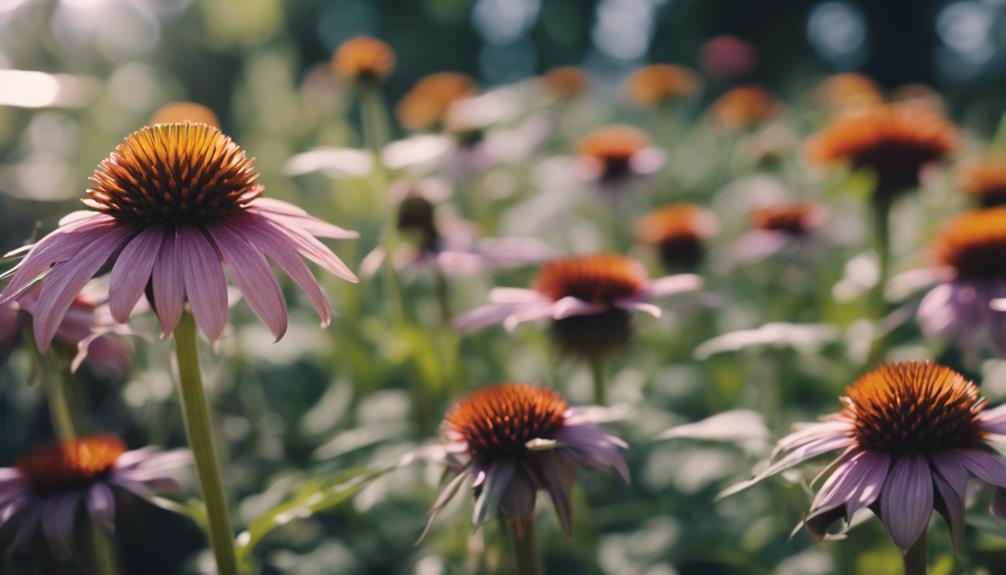Herbology has a rich history, shaped by early herbalists who observed nature, documented plant uses, and combined spiritual and practical knowledge. Ancient civilizations like Egypt, Greece, China, and indigenous cultures each contributed unique practices and texts, improving botanical illustrations and remedy formulations. Pioneers like Hildegard of Bingen and Nicolas Culpeper laid foundations for modern herbal medicine. Exploring these developments reveals how herbal traditions evolved and influence today’s holistic approaches. If you keep exploring, you’ll uncover more fascinating insights into herbal history and its ongoing legacy.
Key Takeaways
- Early herbalists like Hildegard of Bingen and Nicolas Culpeper documented plant properties, healing methods, and herbal classifications.
- Their work blended art, science, and spirituality, laying foundations for modern herbology.
- They created detailed botanical illustrations and herbal texts that improved identification and remedy development.
- Pioneers contributed to understanding plant-based therapies and established early methods of preparing herbal remedies.
- Their contributions influenced subsequent herbal practices and integrated cultural, philosophical, and spiritual healing principles.
The Origins of Herbal Knowledge in Ancient Civilizations
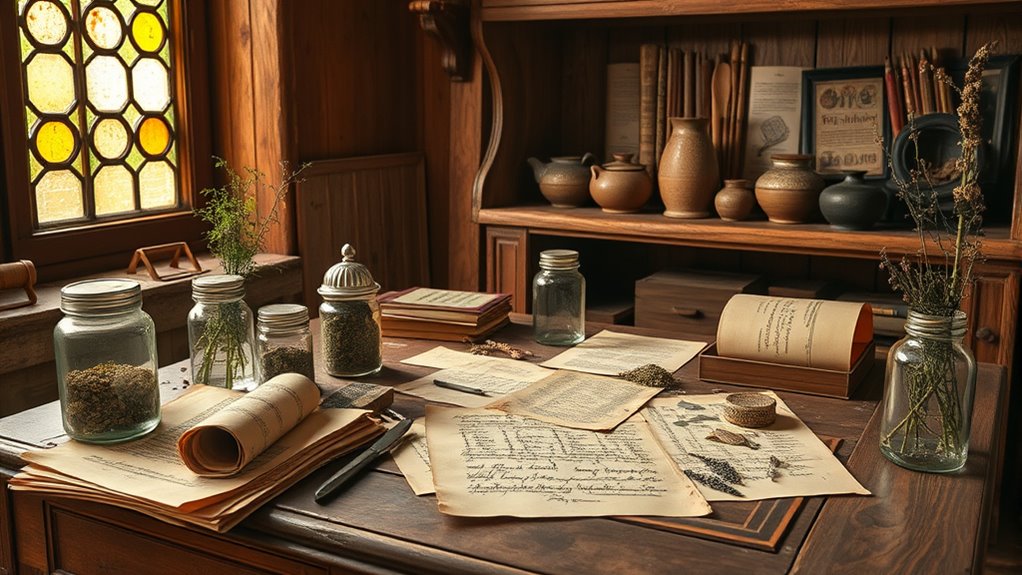
Ancient civilizations laid the foundation for herbal knowledge by observing nature and experimenting with plants for medicinal purposes. They relied heavily on medicinal folklore, passing down remedies and plant uses through generations. As you explore early herbal practices, you’ll notice how herbal symbolism played a crucial role in their understanding. Certain plants were associated with specific qualities or spiritual meanings, shaping how they used herbs in healing rituals. These symbolic associations helped early herbalists identify the most potent plants and understand their effects. This blend of practical experience and spiritual significance created a rich tapestry of herbal knowledge that influenced future practices. Recognizing the cultural significance of herbs offers deeper insight into their traditional uses and symbolic meanings. Additionally, the integration of spiritual symbolism into herbal practices fostered a holistic approach to health and healing. Moreover, the importance of attention in observing plant properties was essential for developing accurate herbal applications. The careful documentation of plant effects by early herbalists contributed to the systematic development of herbal medicine. By recognizing these roots, you gain insight into how herbal traditions evolved from simple observations into complex systems of healing. Furthermore, the use of aesthetic presentation in herbal remedies and tools reflected their importance in cultural practices and healing rituals.
Early Herbal Practices in Ancient Egypt

Ancient Egyptians recorded their herbal knowledge in medical texts and on papyrus scrolls, revealing detailed healing practices. Sacred rituals often involved herbal preparations, linking medicine with spiritual beliefs. Common plants like garlic, aloe, and lotus played essential roles in both healing and religious ceremonies. Additionally, their understanding of herbal medicine laid foundational principles that influenced later herbal practices. Their insights into plant properties also contributed to the development of medicinal formulas, which were passed down through generations. This early experimentation with plant-based remedies form the basis of many modern herbal therapies. Moreover, the Egyptians recognized the importance of energetic alignment in healing, integrating spiritual and physical aspects to optimize health. Their holistic approach underscored the significance of spiritual and physical harmony, which remains a core concept in herbal healing today.
Medical Texts and Papyrus
How did early Egyptian healers record their herbal knowledge? They used medical texts inscribed on papyrus, which served as important references for herbal remedies. These texts often included detailed botanical illustrations, helping healers identify plants accurately. The papyri contained lists of herbs, their medicinal properties, and instructions for preparing remedies. This visual documentation was essential, especially when passing knowledge across generations or sharing with other practitioners. The combination of written descriptions and botanical illustrations made these texts invaluable tools in ancient medicine. Additionally, these records often incorporated herbal classifications, reflecting an early understanding of plant properties and relationships. The use of standardized herbal terminology in these texts facilitated clearer communication among practitioners. Studying these documents reveals early methods of herbal record-keeping, which helped preserve vital knowledge over centuries. By studying these documents, you gain insight into how early herbalists understood plant-based healing and preserved their expertise for future use. These records laid the groundwork for the development of herbal medicine in later civilizations.
Sacred Herbal Rituals
Sacred herbal rituals played a pivotal role in the spiritual and medical practices of early Egypt, blending healing with religious reverence. You might have encountered stories of how sacred plants were used in ritual healing to invoke divine favor or banish illness. These rituals often involved specific plants considered sacred, believed to carry divine power. Herbal offerings were made during temple ceremonies, emphasizing their divine significance. Priests performed ceremonial healing, combining prayers with the use of sacred plants to cure ailments. Resources and tools in ancient Egypt helped preserve and transmit these sacred practices across generations. The use of a Gold IRA in modern times echoes the importance of safeguarding valuable assets, paralleling how ancient herbalists protected sacred knowledge. Through these practices, herbalism became a sacred act, intertwining physical healing with spiritual devotion.
Commonly Used Plants
Building on the spiritual significance of herbal rituals, early Egyptian practitioners relied heavily on a variety of plants for both healing and religious purposes. Medicinal flowers like lotus and blue water lily played crucial roles in their healing practices, believed to have divine powers. Culinary herbs such as coriander, cumin, and dill were essential in daily life, used to flavor food and support health. These plants weren’t just for sustenance; they also held symbolic meaning and were incorporated into sacred rituals. You’d find that many of these herbs and flowers were stored in temples and tombs, emphasizing their importance. The Egyptians understood the profound connection between plants, spirituality, and well-being, laying the foundation for herbal use that influences herbal practices even today. Recognizing the healing properties of these ancient plants highlights their enduring significance in herbal tradition and demonstrates how early herbalists integrated plant-based remedies into their spiritual and medicinal practices. Additionally, their knowledge of medicinal plants contributed significantly to the development of early medical systems.
Contributions of Greek and Roman Herbalists
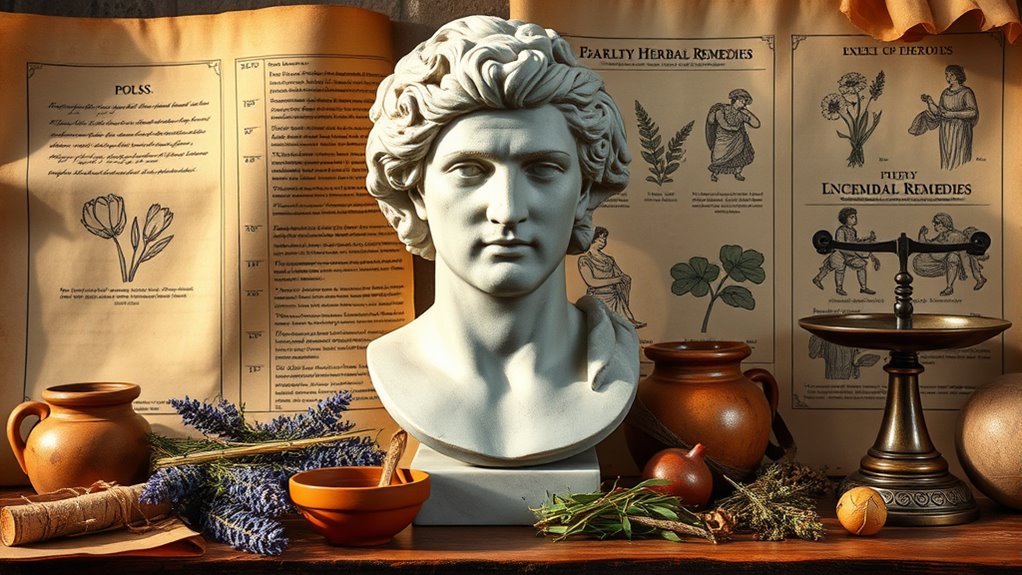
Greek and Roman herbalists laid the foundation for Western herbal medicine by systematically studying plants and their healing properties. They combined Greek philosophy’s focus on nature and the human body with Roman pharmacology’s practical approach to medicinal preparation. Their work influenced centuries of herbal practice. They also contributed to the development of early herbal texts, which served as important references for future practitioners. Here are three key contributions: 1. They documented plant properties and uses, creating early herbals that served as references for future generations. 2. They emphasized empirical observation, noting effects of herbs through trial and error, which reflects a focus on cultural intelligence to understand diverse healing practices. 3. They integrated philosophical ideas, such as balance and humors, into herbal healing practices.
The Role of Chinese Herbal Medicine in Ancient Asia

Chinese herbal medicine has shaped ancient Asian healthcare through unique formulations and healing practices. Its philosophical foundation of Qi emphasizes balance and energy flow, influencing treatment approaches. Today, these traditional principles still impact modern herbal practices worldwide.
Traditional Formulations and Uses
Ancient Asian societies relied heavily on herbal formulations to maintain health and treat illnesses, with Chinese herbal medicine playing a central role in these practices. You would use specific medicinal preparations tailored to individual needs, often combining herbs into complex formulas. These formulations weren’t just for healing; they also carried ritualistic applications, emphasizing spiritual balance alongside physical health.
Here are three key points:
- Formulations were crafted from carefully selected herbs to target specific ailments.
- Ritualistic applications often involved ceremonies to enhance healing efficacy.
- Traditional uses included tonifying the body, detoxifying, and restoring balance within the system.
Philosophical Foundations of Qi
Herbal formulations in traditional Asian practices are deeply rooted in a philosophical understanding of life energy, known as Qi. You recognize that Qi represents the essential energy flowing through the body, maintaining health and balance. Healing philosophies emphasize the importance of energy flow, believing that blockages or imbalances cause illness. Chinese herbal medicine aims to restore harmony by stimulating or regulating Qi, promoting natural healing processes. This perspective shapes how herbs are selected and combined, focusing on their ability to influence energy flow within specific meridians. By understanding Qi, you see how herbal remedies aren’t just about symptom relief but about addressing the root causes of disharmony. This foundation underscores the holistic approach that characterizes Asian healing traditions.
Influence on Modern Practices
The influence of herbal medicine from traditional Asian practices continues to shape modern health approaches in many ways. You can see this in the continued use of medicinal rituals that integrate herbal remedies, emphasizing harmony between mind and body. Additionally, herbal symbolism remains essential, guiding practitioners in selecting herbs based on their spiritual and energetic qualities. Here are three key impacts:
- Modern herbal therapies often incorporate principles from ancient medicinal rituals to enhance healing.
- Herbal symbolism influences product branding and consumer perceptions, connecting herbs to cultural meanings.
- Integrative medicine increasingly combines traditional Chinese herbal practices with Western science, honoring both empirical evidence and spiritual symbolism.
Herbalism in Medieval Europe and the Arabic World
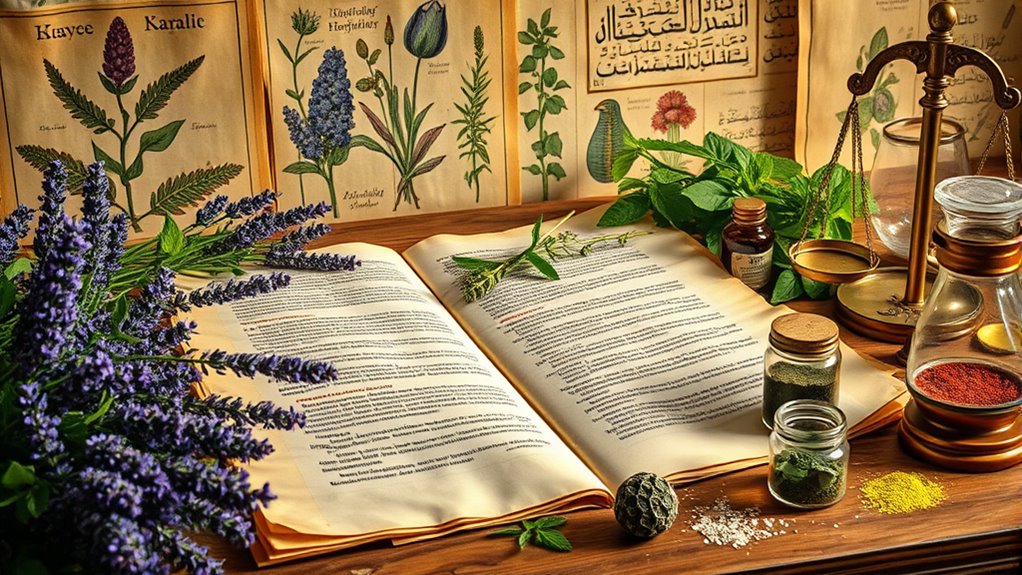
During the medieval period, both Europe and the Arabic world developed rich traditions of herbalism, heavily relying on plants for medicine and healing. You can see this in medieval herbalism, where texts like the *Physica* by Hildegard of Bingen and numerous Arabic medicinal texts became essential references. Arabic scholars preserved and expanded on ancient knowledge, translating Greek and Roman works and adding their insights. These texts detailed plant properties, uses, and preparation methods, influencing European herbal practices. As a result, herbal remedies became more systematic, combining empirical observation with theoretical frameworks. This exchange of knowledge helped lay the groundwork for later medicinal advancements, ensuring that herbal medicine remained a respected and evolving discipline in both regions.
Indigenous and Native American Herbal Traditions
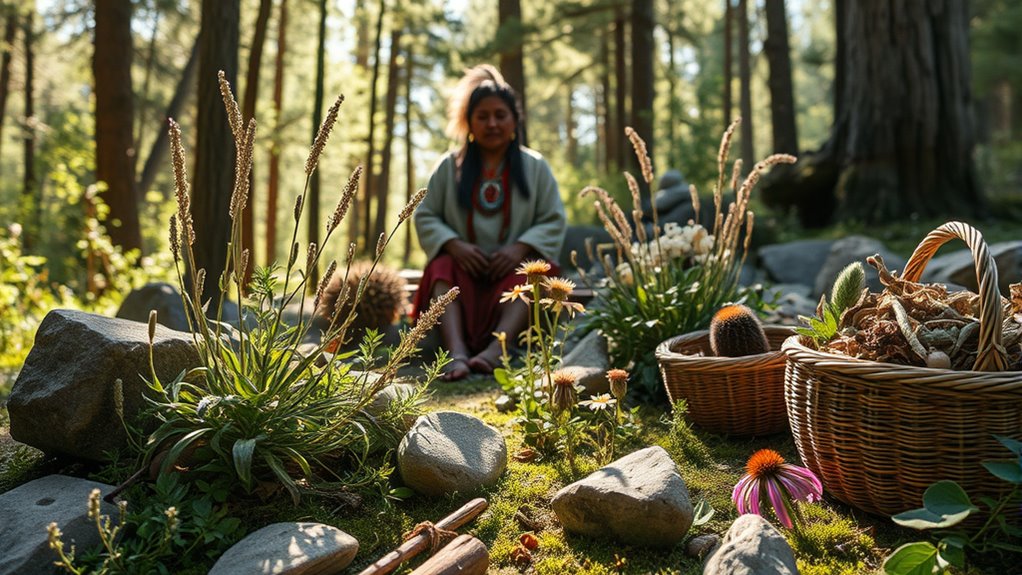
Have you ever wondered how Indigenous peoples of the Americas harnessed the healing power of plants long before European contact? They relied on native plants passed down through generations, using them in herbal ceremonies to promote health and spiritual well-being. These traditions emphasize a deep connection between nature and healing, often involving rituals to honor the plants’ sacred roles.
Some key aspects include:
- Recognizing specific native plants for medicinal uses, like echinacea and yarrow.
- Conducting herbal ceremonies that blend healing with spiritual practices.
- Sharing knowledge orally, preserving centuries of herbal wisdom.
Notable Herbalists and Their Pioneering Works

Throughout history, pioneering herbalists have shaped our understanding of plant medicine through groundbreaking research and innovative practices. Many cultivated medicinal gardens, carefully selecting plants for healing and study. These herbalists documented their discoveries through detailed herbal illustrations, which helped preserve plant features and uses for future generations. For example, Hildegard of Bingen created early herbals that combined botanical drawings with medicinal properties, influencing medieval herbal medicine. Nicolas Culpeper’s work in the 17th century made herbal knowledge accessible to common people, emphasizing practical applications. These herbalists’ contributions laid the foundation for modern herbology, blending artistic herbal illustration with scientific inquiry. Their pioneering works continue to inspire herbalists today, emphasizing the importance of observation, documentation, and the enduring value of medicinal gardens.
The Evolution of Herbal Texts and Manuscripts
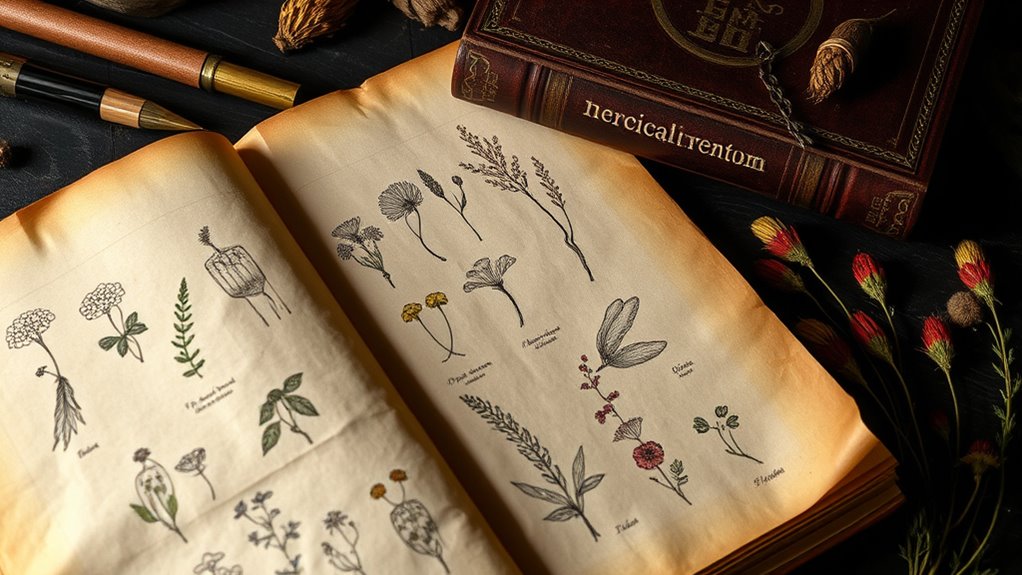
The evolution of herbal texts and manuscripts reveals a fascinating journey from ancient scrolls to detailed printed herbals. As you explore this development, you’ll notice how herbal manuscript development advanced through centuries, improving accuracy and accessibility. The botanical illustration evolution played a significant role, transforming sketches into intricate, scientifically valuable images. To better understand this progression:
- Early herbal manuscripts featured simple texts with basic plant descriptions.
- The introduction of detailed botanical illustrations enhanced identification and understanding.
- The printing press allowed for widespread dissemination, standardizing herbal knowledge.
This evolution reflects a shift from handwritten, localized works to exhaustive, visually rich resources that laid the foundation for modern herbal studies. Your appreciation of herbal texts deepens as you see how artistic and technological advances shaped herbal knowledge over time.
The Impact of Early Herbalists on Modern Medicine

Early herbalists laid the groundwork for modern medicine by systematically observing, cataloging, and utilizing medicinal plants. Their work directly influences herbal therapy today, providing a foundation for safe and effective plant-based treatments. By studying plant properties, early herbalists contributed to plant pharmacology, helping us understand how specific compounds affect the human body. Their careful documentation allowed later scientists to develop standardized extracts and medicines. This historical knowledge enables you to appreciate how traditional herbal practices inform contemporary approaches to natural healing. Without their detailed observations, modern herbal therapy and plant pharmacology might lack the scientific rigor they have today. Their contributions bridge ancient wisdom and current medical research, shaping the way you approach herbal remedies and integrative health.
Frequently Asked Questions
How Did Herbal Knowledge Transfer Between Ancient Civilizations?
You see, herbal knowledge spread through cultural exchange and trade routes, linking ancient civilizations. As merchants and travelers moved between regions, they shared medicinal plants and practices, allowing herbal wisdom to flourish across cultures. These trade routes, like the Silk Road, facilitated the exchange of herbs, techniques, and texts, enriching each civilization’s herbal knowledge and fostering a global understanding of medicinal plants that persists today.
What Methods Did Early Herbalists Use to Identify Medicinal Plants?
Early herbalists identified medicinal plants through careful plant classification, observing features like leaves, flowers, and scent. They often used botanical illustrations to document plant details accurately, helping them distinguish between similar species. By comparing plants with known medicinal properties and sharing their drawings and notes, they improved identification methods, ensuring effective use of herbs. This hands-on approach laid the foundation for modern botany and herbal medicine.
Are Any Ancient Herbal Remedies Still in Use Today?
Yes, many ancient herbal remedies remain in use today. You might find medicinal plants like aloe vera and chamomile still popular for their healing properties, rooted in herbal traditions from centuries ago. These remedies have stood the test of time because they’re effective, and modern medicine often incorporates them. By preserving herbal traditions, you help keep ancient knowledge alive, ensuring these natural treatments continue benefiting people worldwide.
How Did Herbal Practices Influence Early Pharmaceutical Development?
Herbal practices shaped early pharmaceutical development by fueling the herbal trade and encouraging detailed botanical illustrations. You see, early herbalists documented plant properties, which helped scientists understand medicinal benefits. These illustrations made identification easier, ensuring proper use. As a result, these practices laid the groundwork for modern medicine, blending traditional knowledge with scientific research, and highlighting the enduring impact of herbal remedies on pharmaceutical advancements today.
What Role Did Herbalism Play in Spiritual or Religious Rituals?
Herbalism acts as a bridge between the physical and spiritual worlds, where plants symbolize divine connections. You participate in ritual plant preparations, using herbs to invoke protection, healing, or spiritual insight. These plants serve as sacred symbols, guiding rituals that align your intentions with natural energies. You embrace plant symbolism, knowing that each herb’s role in spiritual practice deepens your connection to the divine and enhances sacred ceremonies.
Conclusion
Your journey through herbal history reveals a rich tapestry woven across civilizations, like a timeless garden blooming with knowledge. These early herbalists laid the roots for modern medicine, turning ancient whispers into scientific symphonies. As you walk this path, remember their pioneering spirits continue to inspire, reminding you that the wisdom of the past is the seed from which tomorrow’s healing blossoms. Embrace this legacy, and nurture your own connection to nature’s healing embrace.




